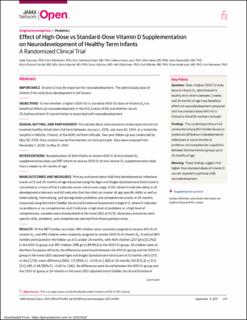| dc.description.abstract | Importance Vitamin D may be important for neurodevelopment. The optimal daily dose of vitamin D for early brain development is not known.
Objectives To test whether a higher (1200 IU) vs standard (400 IU) dose of vitamin D3 has beneficial effects on neurodevelopment in the first 2 years of life and whether serum 25-hydroxyvitamin D concentration is associated with neurodevelopment.
Design, Setting, and Participants This double-blind, interventional randomized clinical trial involved healthy infants born full-term between January 1, 2013, and June 30, 2014, at a maternity hospital in Helsinki, Finland, at the 60th northern latitude. Two-year follow-up was conducted by May 30, 2016. Data analysis was by the intention-to-treat principle. Data were analyzed from November 1, 2020, to May 31, 2021.
Interventions Randomization of 404 infants to receive 400 IU of oral vitamin D3 supplementation daily and 397 infants to receive 1200 IU of oral vitamin D3 supplementation daily from 2 weeks to 24 months of age.
Main Outcomes and Measures Primary outcomes were child total developmental milestone scores at 12 and 24 months of age measured using the Ages and Stages Questionnaire (total score is calculated as a mean of the 5 subscale scores: total score range, 0-60, where 0 indicates delay in all developmental domains and 60 indicates that the child can master all age-specific skills) as well as externalizing, internalizing, and dysregulation problems and competencies scores at 24 months measured using the Infant-Toddler Social and Emotional Assessment (range 0-2, where 0 indicates no problems or no competencies and 2 indicates a high level of problems or a high level of competencies; variables were standardized to the mean [SD] of 0 [1]). Secondary outcomes were specific skills, problems, and competencies derived from these questionnaires.
Results Of the 987 families recruited, 495 children were randomly assigned to receive 400 IU of vitamin D3, and 492 children were randomly assigned to receive 1200 IU of vitamin D3. A total of 801 families participated in the follow-up at 12 and/or 24 months, with 404 children (207 girls [51.2%]) in the 400-IU group and 397 children (198 girls [49.9%]) in the 1200-IU group. All children were of Northern European ethnicity. No differences were found between the 400-IU group and the 1200-IU group in the mean (SD) adjusted Ages and Stages Questionnaire total score at 12 months (45.0 [7.1] vs 46.2 [7.9]; mean difference [MD], 1.17 [95% CI, –0.06 to 2.38]) or 24 months (50.9 [5.3] vs 51.5 [5.5]; MD, 0.48 [95% CI, –0.40 to 1.36]). No differences were found between the 400-IU group and the 1200-IU group at 24 months in the mean (SD) adjusted Infant-Toddler Social and Emotional Assessment externalizing domain score (–0.07 [1.00] vs 0.07 [0.98]; MD, 0.15 [95% CI, –0.01 to 0.31]), internalizing domain score (0.04 [1.06] vs –0.02 [0.98]; MD, –0.07 [95% CI, –0.24 to 0.1.0]), dysregulation domain score (–0.00 [1.04] vs 0.02 [0.96]; MD, 0.02 [95% CI, –0.14 to 0.18]), or competencies score (–0.02 [1.02] vs 0.01 [1.02]; MD, 0.03 [95% CI, –0.13 to 0.20]). The 1200-IU group did have a higher risk in the adjusted model of scoring 1.5 SDs or more on the externalizing domain score (odds ratio, 2.33 [95% CI, 1.19-4.56]; P = .01). Levels of serum 25-hydroxyvitamin D were not associated with the primary outcomes.
Conclusions and Relevance Higher-than-standard vitamin D3 doses provide no systematic benefits for child neurodevelopment up to 2 years of age. However, the potential disadvantageous effects of higher doses could not be fully excluded; even if minimal, the potential nonbeneficial effects of higher-than-standard doses warrant further studies in which both safety and benefits should be evaluated. | en_US |

